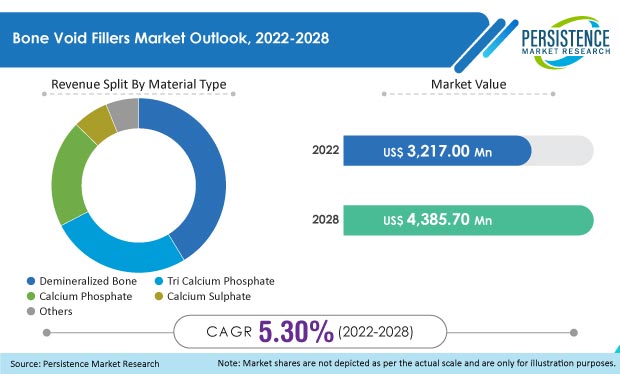Bone Void Fillers Market Segmented By Demineralized Bone, Calcium Sulphate, Calcium Phosphate, Tri Calcium Phosphate Material Type in Putty, Paste, Gel, Granules, Beads, Sponge, Strip, Fiber Form
Industry: Healthcare
Published Date: May-2022
Format: PPT*, PDF, EXCEL
Delivery Timelines: Contact Sales
Number of Pages: 182
Report ID: PMRREP20944
The Bone Void Fillers Market witnessed a CAGR of 4.6% between 2014 and 2021. The global Bone Void Fillers Market is expected to have a 5.3% CAGR between 2022 and 2029. In 2022, the global Bone Void Fillers Market size was US$ 3,217 million, which is projected to reach US$ 4,385.7 million by the year 2029.
| Attribute | Key Insights |
|---|---|
|
Bone Void Fillers Market Size (2022) |
US$ 3,217 Mn |
|
Projected Market Value (2029) |
US$ 4,385.7 Mn |
|
Global Market Growth Rate (2022-2029) |
5.3% CAGR |
|
Share in parent market |
8.5% |
The Bone Void Fillers Market is expected to witness a CAGR of 5.3% during the forecast period between 2022 and 2029. The rise in the prevalence of orthopedic problems such as osteoporosis, spinal deformity, and spinal injuries is driving the expansion of the bone void fillers market.
The rising prevalence of orthopedic disorders such as bone tumors and osteomyelitis is boosting the market growth. Bone Void fillers are most commonly used to treat chronic osteomyelitis. In the near future, the increase in sports injuries and other forms of trauma, bone lesions, and bone fractures are expected to fuel the market growth.

Clinical constraints such as bone infection during operations have prompted the use of antibiotics eluting void fillers. Companies are concentrating on R&D initiatives and launching antibiotic eluting void fillers that can also decrease the chances of bone infections. Furthermore, the increased significance of clinical research to develop medications for the treatment of bone disorders is also expected to drive market growth.
The rapidly expanding use of synthetic bone void fillers like calcium sulfate and tricalcium phosphate is likely to fuel market expansion. These fillers have various benefits, such as lower morbidity, high sterility, etc. The increasing use of these fillers instead of the other sources of bone graft replacements will contribute to growth in demand throughout the projected period. Synthetic bone void fillers are made of tri-calcium phosphate (the most identical chemical composition to human bone), and are widely utilized as bone void filler. The increasing use of these types of fillers in place of the other sources of bone graft replacements will contribute to a growth in demand throughout the projected period.
Various clinical restrictions and poor penetration of bone void filling material are causing a decrease in demand. This decreased acceptance is because of the significant hazards and risks involved with its use, which include incomplete or no bone growth, infection of soft tissue and bone, filler rupture, etc. Furthermore, the invasive aspect of these fillers may restrict their global acceptance, which can hamper the overall market growth.
The cost of orthopedic surgery varies according to geography and surgeon experience. The typical cost of orthopedic surgery can be between $25,000 and $30,000, including consultancy costs. If bone void fillers are required during surgery, extra expenditure of US$ 1,000 to US$ 2,000 is required. As a result, the high costs associated with Orthopedic surgeries are a significant issue impeding the growth of the global bone void fillers market.
“Significant Decrease in Demand”
The COVID-19 pandemic wreaked havoc on the global economy, and it had a negative impact on the Bone Void Fillers Market. The advent of COVID-19 led to a decrease in demand for bone fillers because of the cancellation and postponement of orthopedic procedures due to the restrictions and guidelines imposed by various governments around the world. The restrictions led to a decrease in the volume of surgeries, interruptions in supply chains, which resulted in a severe drop in revenue for market players. However, elective procedures, including orthopedic surgery and trauma surgery, began to resume in 2021 when regulations were lifted. Patient and surgery volumes increased as a result of strict guidelines and COVID-19 protocols in public places, as well as the removal of travel limitations.
The Bone Void Fillers industry is moderately competitive and highly consolidated due to the presence of several large players. Key players in the market are focusing on mergers and acquisitions as the industry is in the growth phase. Companies are making strategic decisions to engage in mergers and acquisitions in order to expand their product portfolios and grow their market share.
| Attribute | Details |
|---|---|
|
Forecast Period |
2022-2029 |
|
Historical Data Available for |
2014-2021 |
|
Market Analysis |
US$ Mn/Bn for Value |
|
Key Regions Covered |
|
|
Key Countries Covered |
|
|
Key Market Segments Covered |
By Type |
|
Key Companies Profiled |
|
|
Customization & Pricing |
Available upon Request |
Bone Void Fillers Market by Type
Bone Void Fillers Marketby Region
To know more about delivery timeline for this report Contact Sales

In 2022, the Bone Void Fillers Market stands at USD 3,217 million, and it is expected to reach USD 4,385.7 million by 2029 at a CAGR of 5.3%.
Bone Void Fillers Market exhibited a 4.6% CAGR between 2014 and 2021.
Low Penetration and Clinical Barriers along with High Surgery Costs are the key restraints in the Bone Void Fillers Market.
The increasing Prevalence Of Orthopedic Problems along with the Increase in the Adoption of Antibiotic-Eluting Bone Void Fillers and Synthetic Bone Void Fillers are the key factors driving the growth of the market.
Johnson and Johnson, Zimmer Biomet, Stryker Corporation, NuVasive®, Inc., and Hoya Corporation are among the top players in the market.